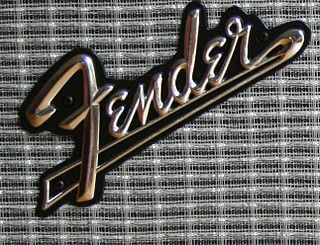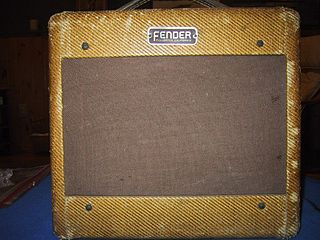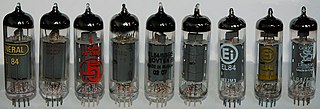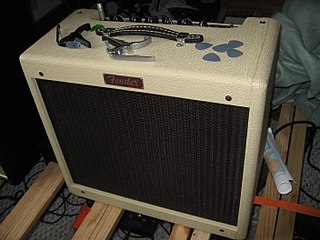
A guitar amplifier is an electronic device or system that strengthens the weak electrical signal from a pickup on an electric guitar, bass guitar, or acoustic guitar so that it can produce sound through one or more loudspeakers, which are typically housed in a wooden cabinet. A guitar amplifier may be a standalone wood or metal cabinet that contains only the power amplifier circuits, requiring the use of a separate speaker cabinet–or it may be a "combo" amplifier, which contains both the amplifier and one or more speakers in a wooden cabinet. There is a wide range of sizes and power ratings for guitar amplifiers, from small, lightweight "practice amplifiers" with a single 6" speaker and a 10 watt amp to heavy combo amps with four 10” or four 12" speakers and a powerful 100 watt amplifier, which are loud enough to use in a nightclub or bar performance.

Peavey Electronics Corporation is an American company that designs, develops, manufactures and markets professional audio equipment. It is one of the largest audio equipment manufacturers in the world, headquartered in Meridian, Mississippi.

Mesa/Boogie is an American company in Petaluma, California, that manufactures amplifiers for guitars and basses. It has been in operation since 1969.

Leo Fender began building guitar amplifiers before he started manufacturing electric guitars. The first of these were the K&F models, produced between 1945 and 1946. The early K&F and Fender amplifiers relied upon vacuum tube circuitry, with the company adding solid-state models in the late 1960s.

SWR Sound Corporation is a specialist manufacturer of bass guitar amplifiers, preamps, speaker cabinets, and acoustic guitar amplifiers.
Boutique amplifier is a catch-all descriptor for any type of instrument amplifier that is typically hand built with the intention of being much better than the mass-produced variety offered by large companies. In the majority of cases, this is reflected in the price. Sometimes they are clones of older designs, often with minor improvements or alterations in layout or circuit design; sometimes they are new designs altogether.

The Fender Twin is a guitar amplifier made by Fender Musical Instruments Corporation. It was introduced in 1952, two years before Fender began selling Stratocaster electric guitars. The amps are known for their characteristically clean tone.

The Fender Hot Rod Deluxe is a guitar amplifier manufactured and sold by the Fender Musical Instruments Corporation. It was introduced in 1996 as part of the "Hot Rod" line of guitar amplifiers and has been in continuous production since. The Hot Rod Deluxe is a modified version of the Fender Blues Deluxe from the earlier Blues line of amplifiers, and has a higher level of gain in its preamplification signal. This model, along with the Hot Rod Deville, were originally designated as F.A.T. amplifiers but this moniker was dropped in 2002 when production of this series of amps was moved from Corona, CA to Fender's Baja-Ensenada, Mexico manufacturing facility.

The Fender Bassman is a bass amplifier introduced by Fender during 1952. Initially intended to amplify bass guitars, the 5B6 Bassman was used by musicians for other instrument amplification, including the electric guitar, harmonica, and pedal steel guitars. Besides being a popular and important amplifier in its own right, the Bassman also became the foundation on which Marshall and other companies built their high-gain tube amplifiers.

The Fender Super Reverb is a guitar amplifier made by Fender. It was originally introduced in 1963 and was discontinued in 1982. The Super Reverb was a Fender Super amplifier with built-in reverb and "vibrato". The original Super Reverb amplifiers were all-tube designs and featured spring reverb. There were two different designs, distinguishable by the color of the "face" or front control panel. Super Reverbs from 1963 through 1967 had "blackface" panels. From 1968 until its discontinuation in 1982, the Super Reverb had "silverface" cosmetics and circuitry. Early models in 1968, while cosmetically "silverface", did contain "blackface" circuitry. Fender introduced a reissue '65 Super Reverb in 2001 featuring a printed circuit board design rather than the hand-wired circuitry of the original '65 Super Reverb.

The Fender Hot Rod DeVille is a combo tube guitar amplifier manufactured and sold by Fender. It was introduced in 1996 as part of Fender's Hot Rod line of amplifiers, and since then has been in continuous production. The Hot Rod DeVille is a modified version of the earlier Fender Blues DeVille from the Blues amplifier line, and has a higher level of gain in its preamplification signal. The DeVille incorporates a 60 watt amplifier, and is available in two different models: a 212, which includes a pair of Celestion A-Type 12" speakers, and the 410, which includes four 10" speakers. The DeVille is the sister amplifier of the Fender Hot Rod Deluxe.
The Fender Concert was a guitar amplifier made by Fender Musical Instruments. Its production can be split over 2 phases. The first of these running from 1960 and until approximately 1965, at which time a typical Fender Concert was priced at $315. During the 1960s, the Concert was for all practical purposes the same amplifier as the Vibrasonic but with four 10" speakers. In a later phase, the Concert was updated by Paul Riviera in the early 1980s and a subsequent 1x12 variant of the Concert amp appeared briefly in the mid-1990s.

The Fender Princeton was a guitar amplifier made by Fender. It was introduced in 1947 and discontinued in 1979. After Fender introduced the Champ Amp in 1948, the Princeton occupied the next to the bottom spot in the Fender line. Fender Princetons from the early models into the 1970s models are highly valued particularly as recording amplifiers.

The Fender Super was a guitar amplifier made by Fender between 1947 and 1963 and, as the Super Reverb, until 1981. Though it was designed for a clean sound, its overdriven sound is praised by players and critics.

Fender tweed is a generic name used for the guitar amplifiers made by the American company Fender between 1948 and 1960. The amplifiers are named for the cloth covering, which consists of varnished cotton twill, incorrectly called tweed because of its feel and appearance. They are praised for their sound, their circuitry considered "hallowed ground". Fender generally stopped using the twill covering in 1960, though the Harvard was still covered in twill until 1963, and the Champ until 1964.
The Fender Deluxe guitar amplifier was produced by Fender from early 1948 to 1966. Its predecessor was the Fender Model 26 "Woodie" produced from 1946 to 1948.

The Fender Pro Reverb is a high-end guitar amplifier made by Fender. It was in production from 1965 and was discontinued in 1982. The Pro Reverb is a 40-watt tube amplifier and has a pair of 12" speakers; however, models later than 1976 were increased to 70 watts. Teagle and Sprung, authors of the definitive book on Fender amplifiers described the Blackface Pro Reverb as the best amplifier ever produced likely due to its combination of the two twelve inch speakers, its high quality reverb and tremolo, and just the right amount of power to get either classic Blackface Fender cleans or natural tube breakup at reasonable volumes. They wrote, "the author recommends these amps as the best all-around amp ever made—by anyone".

The Fender Harvard is a vacuum tube (valve) guitar amplifier made by Fender from 1955 to 1963. The Harvard appeared only in a tweed covered "narrow-panel" cabinet, but in two very different circuit designs, namely 5F10 (1955-61) and 6G10 (1962-63).





















